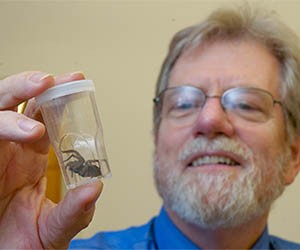
We Shouldn t Fear the Big, Bad Wolf (Spider, That Is)
Longtime University of Cincinnati professor George Uetz studies how the environment influences the evolution of behavior through researching animal behavior and ecology. Uetzs research focuses on spiders, in particular wolf spiders and colonial web-building spiders.
Although many psychologists disagree on whether human fear of spiders is innate or learned, Uetz argues that there is nothing to fear about these creatures. He explains that this fear is mostly perpetuated as a consequence of misinformation, especially nowadays via the Internet.
Spiders are mostly harmless and bite people far less frequently than suspected, Uetz explained. Indeed, one study showed more than 80 percent of physician-diagnosed Brown Recluse spider bites are likely something else.
Uetz believes that researching and understanding the natural world can help us achieve advances in areas that contribute to economic growth, such as human health and medicine, environmental quality and conservation of natural resources, agriculture and forestry.
Spiders not only play a huge role in nature, but also can also help contribute to a number of economic enterprises.
For example, there is spider silk that is stronger than steel and spider venom that is used in the pharmaceutical industry. Additionally, there are spiders used as a biological control of pests in agricultural crops as well as spider-inspired biomimetic robotics.
The National Science Foundation helps fund Uetzs most recent research, which focuses on the Brush-legged wolf spider,
Schizocosa ocreata.
In particular, he researches how these spiders communicate using different sensory modes: visual, vibratory and chemical.

Male schizocosa ocreata
In his research, Uetz also examines how aspects of the physical environment influence the evolution of signals sent by male spiders and received by female spiders. Some of the observed characteristics include moisture in the environment, the light spectrum and the structure of substrate.
In the case of the wolf spiders I work on, Uetz said, they are very abundant in deciduous forests and are an important component of the forest floor in local woods.
Another type of
was recently found in Adams County at a nature preserve run by the Cincinnati Museum Center and the Nature Conservancy. The
Hogna carolinensis,
or the Carolina wolf spider, is the biggest wolf spider in America and had not been seen in Ohio for more than 60 years. Because the two types of spiders occur in the same area, it is likely that the Carolina wolf spider would prey upon the smaller
Schizocosa ocreata
.
Throughout his time at UC, Uetz has been sharing his knowledge regarding these spiders with the 39 graduate and 150 undergraduate students who have participated in his research over the years.
Related Stories
WVXU: Test your word puzzle skills with a Cincinnati...
April 18, 2024
Cincinnati edition host Lucy May discusses the history and new found popularity of word games with Michael Griffith, professor English. Griffith is a writer, but also develops word games for publication.
Jason and Travis Kelce take Cincinnati to ‘New Heights’
April 16, 2024
UC alumni Jason and Travis Kelce returned to UC for an unforgettable evening that included the Great "Lombaby" Games, a live recording of their podcast "New Heights," special guests Joe Burrow, Orlando Brown Jr. and Desmond Ridder and a surprise commencement ceremony.
UC President Neville Pinto shares 2024 State of the University...
April 16, 2024
University of Cincinnati President Neville G. Pinto shared his 2024 Sate of the University address with the campus community on April 15.
